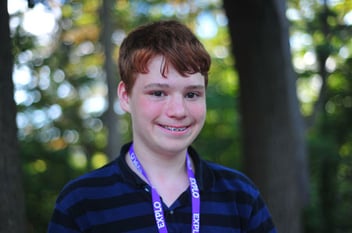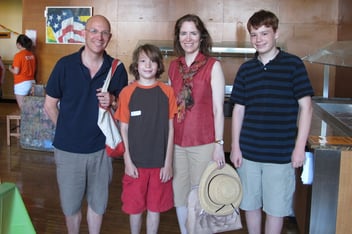Explo's Top Takeaways from SXSWedu

For this year’s SXSWedu — a global education conference in Austin, Texas — Explo packed up the wind tunnels, readied Captain Fraido Heights for flight, and returned more inspired than ever.
Every year, SXSWedu brings together an international mix of educators, students, and innovators to "foster innovation in learning." Explo was accepted to create an exhibit in the SXSWedu Playground, where we invited conference goers to see how we approach hands-on, project-based learning.
Throughout our week at SXSWedu — whenever we weren't manning the Explo booth — we were busy exploring all the other wonderful booths and makerspaces, and immersing ourselves in a whole new world of learning. Here's a compendium of our top SXSWedu takeaways.
 Launching Capt. Fraido Heights
Launching Capt. Fraido Heights
In our SXSWedu wind tunnel makerspace, Explo staff members introduced students and educators to Captain Fraido Heights — and invited them to design, test, and redesign paper parachutes for flight. It was a resounding success.
Effective Learning is Interdisciplinary
Kristi Jacobi (@ExploKristi), Director of Explo Mini + Assistant Director of Curriculum + Instruction: Interdisciplinary learning is being taken to the next level and beyond. Imagine a class where students write and perform an original screenplay (and original songs) that also includes a robot character they built and programmed for their show.
We need to continue to consider the many different ways that people learn — whether visual, kinesthetic, auditory or other. Technology can be helpful in this, by providing apps or other ways of exploring things in different ways, but we also just need to be more human. Listen to each other, consider other points of view, and give up on the notion of one "right" way to do or learn something.
That workshop you can't stop thinking about, even 24 hours later. #sxroboarts#sxswedu#RainbowWizardUnicornForeverpic.twitter.com/JxLt7SOuZv
— Explo Kristi (@ExploKristi) March 9, 2016
Teaching is More Important Than Ever
Laura Farmer (@LauraSFarmer), Curriculum Developer: Tools are tools, and they are wonderful, but they are not what's doing the teaching. The most important thing in the classroom is still the teaching.
In other words — you can't throw a lot of supplies and tools into a room and have a fantastic outcome (or if you do, you are just lucky). Teachers are what make the difference in the maker (or any hands-on) learning environment. We can't throw 3D printers at kids and expect them to suddenly be makers.
We love meeting passionate educators! @mkelly_explo@ExploKristi@LauraSFarmer + @cveresan#SXSWedu#ExploFraidopic.twitter.com/xjfTtvGPB3
— Explo (@ExploLive) March 9, 2016
To Learn Well, Playtime is Essential
Jonathan Griffiths (@CagedChimp), Curriculum Developer: For far too long, [playtime] has left and students have suffered through lecture after lecture. We need to change that, and bring more fun back to learning. We want schools to become places where students can explore new ideas and have the opportunity to learn through play — rather than continue learning through more passive, traditional methods.
Wowed by this homemade seismograph built by a local 5th grader in Austin, way to be a #Maker! #SXSWEdupic.twitter.com/SJCSE2ATwX
— Explo Kristi (@ExploKristi) March 10, 2016
Equity in Education is Critical
Tim Watson (@TimWatsonExplo), Director of Admission: One of the biggest problems in our country, and specifically in low-income communities, is summer learning loss. Even just after elementary school, children who don’t have access to summer learning opportunities can fall as far as one full year behind classmates who do. Working to build equity in education is crucial to reversing this trend, and folks in the Finnish education system (considered the best public school system in the world) agree.
Laura: SXSWedu keynote speaker (and littleBits founder) Ayah Bdeir talked about how as educators we can't "fight the standards," we need to work together with those creating the standards to find a new way forward that includes getting student's hands dirty and meeting specific learning outcomes.
Great to hear from @pasi_sahlberg and @sakuidealist@SXSWedu. Excellent session. Excellent speakers. @ExploLivepic.twitter.com/mHlc15dVWS
— Tim Watson (@TimWatsonExplo) March 8, 2016
The Best Assessments are Student-Driven
Kristi: Portfolios are the up-and-coming assessment tool for learning and especially for making. Giving students the chance to record not just their product but their process provides and opportunity for them to explore and understand the best way they can learn, pinpoint how mistakes led to understanding, and understand themselves as learners, not just producers or direction-followers. This summer, Explo Maker will be using a digital portfolio process including photos, videos, and narratives.
Falling in Love with Austin
Kristi: Gourdough's makes a treat called a "Baby Rattler" — a fried donut covered in fudge sauce, crumbled oreos, and a two-foot long gummy snake that is to die for.
Jonathan: There is a very, very large urban bat colony living under a bridge. How it differs from rural bat colonies I’m not sure, at least in the biological sense, but it is fascinating — and possibly terrifying — when you admire the sheer number of bats that emerge from that bridge on a nightly basis.
Tim: Austin is an amazing city. It is one of the fastest growing cities in the United States. Great music, great food, and wonderful people. Worth a visit. You may never leave!
Virtual Reality: Equalizing Access to Education
Jonathan: Through 360 video, virtual tours, and even iPad apps that transform paper into beating hearts, students are starting to become engaged in ways that were never before possible. Students can now access expensive or otherwise inaccessible things with little more than a cell phone or tablet. With the advent of new technology such as the Oculus Rift and even Google Cardboard, educators are starting to integrate VR in their lessons. And as the technology matures, it will just become more and more a part of everyday life in education.
Built our own computer w/ @TeamKano! It was awesome! This could be an excellent computer to learn code! #SXSWedupic.twitter.com/kYzHDeVuGR
— Jonathan Griffiths (@CagedChimp) March 9, 2016
Educators Need to Stay Ahead of the Curve
Jonathan: Rather than relying on one or two types of technology (particularly 3D printers), makerspaces need to embrace all the tools and tech available and become innovative spaces where people can build, make, create, destroy and rebuild.
Laura: Educators want their students to be makers, but most are struggling with how to make it happen in their schools, libraries, and makerspaces. Ease of access to materials, kits, tools, and packages is imperative for hands-on and project-based learning to continue and grow.
Ran into @AdamGismondi, an @ExploLive Faculty Alum, today at #SXSWedu! He gave the #ExploFraido challenge a shot! pic.twitter.com/XG9upccrEl
— Jonathan Griffiths (@CagedChimp) March 8, 2016
The Maker Movement is Going Global
Kristi: The maker movement is growing at the speed of light, and the definition of a “makerspace” is growing as well. From a mobile cart to an abandoned airport hanger, kids are getting the chance to “make” in every space imaginable.
Laura: Imagine old trucks turned into portable makerspaces. Beautiful carts full of tools that can be wheeled from classroom to classroom. Getting students to put their hands on the tools and start making is the goal, and creating portable, easy ways to do this is allowing schools that would otherwise not have makerspaces get in on the game.
"We learn more from looking for the answer to a question and not finding it than we do learning the answer itself." #SXSWEdu#Makers
— Explo Kristi (@ExploKristi) March 10, 2016
The Future of Education is Now
Tim: Educators know that change is critical. However, if we sit still, we become Nokia and we disappear. It’s important to constantly think about what to change and how to change, even when things are going well.

 Launching Capt. Fraido Heights
Launching Capt. Fraido Heights

